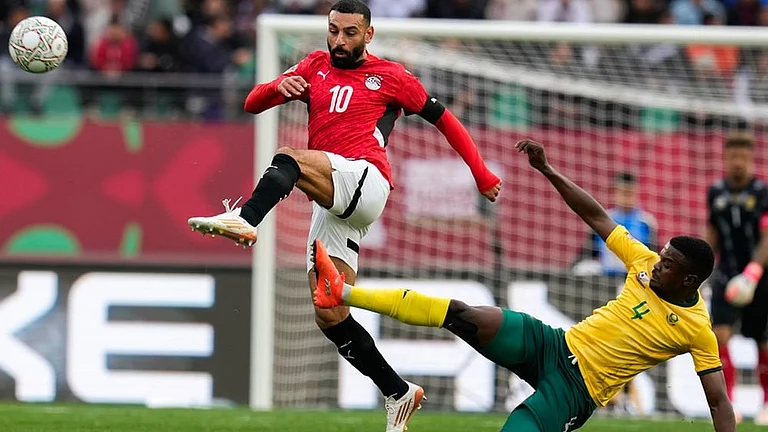AT a Delhi fast food joint, a group of teenagers are engaged in a passionate debate. One of them shows off his birthday gift—a pair of blunt, chunky shoes marked with a crossed-darts logo, called the Vector. "Nothing to match a Reebok. You have to book the DMX in advance. Only limited numbers come. Costs Rs 4,490. It's really cool," he preens. "I think Reebok is no patch on Nike. It's tough. It's what real guys wear," counters another adolescent. His feet carry the distinctive Nike swoosh.
What is it about Nike and Reebok that makes teenagers lust for one or the other? Worldwide, the Reebok-Nike war goes far beyond a struggle for young feet. It's hearts and minds which are at stake here. In India, the battle has only just begun.
Strangely enough, the two arch-rivals are approaching the market in diametrically opposite ways, both claiming they are bang on target. Perhaps it's the Indian market's unmatched complexity that's the real issue. Didn't someone once say that whatever is true of India, the opposite is also equally true?
For instance, Reebok sees some 2.5 million pairs of Indian feet to be dressed up. Nike reckons it's 1 million pairs growing at 25-30 per cent a year. Reebok is approaching the market as a highly segmented one, with a large volume-driven value-for-money segment. Nike wants to be a niche player.
Reebok's splurging on getting Indian sport stars to endorse it. Nike'd rather stick to grassroot fitness development. Reebok wants to be the "most happening, exciting brand for the young"—that is, a lifestyle brand—while Nike doesn't want to dilute its reputation as the brand for athletic performance. Nike runs its global advertising campaigns, while Reebok even has a special baseline for its Indian ads, and not the international "Planet Reebok".
The market-kshetra is primed to see some gore. So here goes:
The Reebok Gameplan: At the heart of the Reebok strategy—to shoe-horn 250,000 pairs of feet in 1997—is getting charismatic Indian endorsers. The latest campaign is built around Rahul Dravid. The line "Tomorrow is Mine" carefully plays on youthful aspirations, tying them in with the unspoken belief that Dravid could become India's main batsman and skipper. "Today's generation is vastly different in terms of aspirations, attitudes and achievement orientation. There is no losing-is-part-of-the-game philosophy. Dravid epitomises that spirit," says Siddharth Verma, Reebok's executive director. Reebok has already signed up soccer wunderkind Baichung Bhutia and squash star Misha Grewal; more are in the pipeline. The company is introducing product lines to cater to local preferences. And simultaneously, perhaps to counter the perception that it was bringing in outdated models, it proposes to launch products to coincide with their worldwide launch. All in the Rs 4,000-plus category for customers with specialised technical needs. Or rich kids.
But Reebok wants more than only rich kids. "The Indian middle class is a disparate grouping of various income clusters and hence our pricing strategy that offers a range beginning with Rs 290 and going up to Rs 4,490," points out Verma.
To support its huge range—which includes tracksuits, athletic jackets, warm-ups, socks and caps—Reebok is pumping up distribution. Currently, 350 multi-brand outlets in 105 urban centres sell Reebok. This in addition to 45 flagship stores in major cities. Plus, it is entering direct retailing through upscale concept stores in Delhi. Nike concedes that Reebok's sales have been spurred by the launch of the low-priced models coupled with better visual merchandising.
The Nike Assault: Nike just wants the cream. At least for now. No Indian sports stars for the brand, which believes it doesn't need anyone to vouch for its sheer product quality. Says G.K. Nayar, managing director: "The Nike customer is well-educated, quite widely-travelled, aware and settles for nothing but the best. We believe he is lured by performance. He doesn't mind paying a little more if he is assured of the latest models and best quality. You will never have a shoe at Rs 290 from Nike. It dilutes the brand image and customer perception."
Nike's range starts at Rs 1,599. And it plans to import limited quantities of its top-of-the line international products, like Air Jordans priced at around Rs 10,000, subject to import clearance. Though it does say it's firming up plans to indigenise its models to give quality shoes at lower prices. As for Indian endorsers, the company says that worldwide, Nike athletes—whether Andre Agassi or Tiger Woods—stand out as mavericks with a disregard for conventions, underlined with a conviction to win. "No Indian sportsperson fits that bill. And the MTV generation is the same all over the world. An Indian teenager's icon is not limited by national boundaries," opines Nayar.
NIKE would rather go for grassroots mechanics. Besides being active at the school and college level, as a part of a worldwide programme, it will hold zonal tennis tournaments next year to sponsor players for the Australian Open. That's how Nike sees the fitness culture developing and thereby the market for its shoes.
Nike's distribution strategy focuses on the major metros where it sees 70 per cent of its market. Its frontline staff, referred to as Ekins (Nike spelt backwards), keep touring its "Just Do It" stores, explaining to customers the function of new products, checking on merchandising and coaching store staff on the Nike technology advantage. The thrust is on the product. The rest can wait. The Nike show is run by only eight managers out of a spartan and unpretentious building on the outskirts of Delhi. "We want to grow and then invest," says Nayar.
So, Who's Winning? Both, or at least that's what the arch-rivals claim. While Reebok completed two years in India last month with total sales of 275,000 pairs, Nike claims that despite coming in six months after Reebok, it's sold around 1,50,000 pairs.
The betting is even on both sides. Says Adarsh Gupta, managing director, Liberty Shoes: "Reebok seems unsure of its long-term strategy. It wants to get into direct retailing, fitness clubs, export deals. It's making a splash with mega endorsements while at the same time wanting to compete with local brands through local sourcing. Seems a tall order. Nike seems to be on a more stable wicket." Others disagree. "Reebok might just be the winner," says an industry source. "After all, Pepsi and Mastercard dominate world leaders Coke and Visa on Indian turf." That curious Indian bazaar logic again, whereby the global order gets inverted here—Nike is bigger internationally.
Anyway, whatever is true of India, the opposite is also....


























